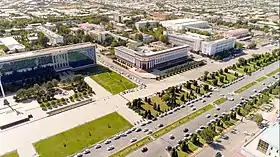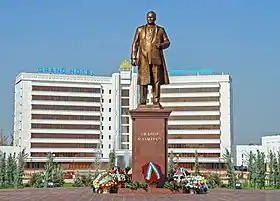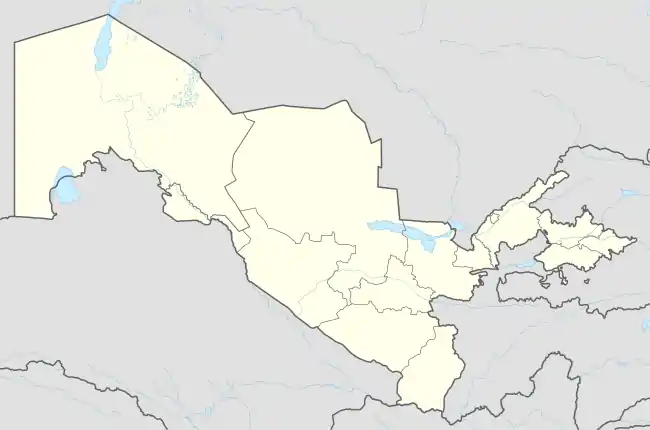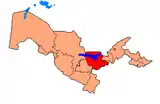Jizzakh
Jizzakh (Uzbek: Jizzax/Жиззах, جىززﻩخ) is a city (population 923,570 in 2014) and the center of Jizzakh Region in Uzbekistan, northeast of Samarkand. The population of Jizzakh on April 24, 2014, was approximately 324,136.[1]
Jizzakh
Jizzax / Жиззах | |
|---|---|
City | |
    | |
 Seal | |
 Jizzakh Location in Uzbekistan | |
| Coordinates: 40°06′57″N 67°50′32″E | |
| Country | |
| Region | Jizzakh Region |
| First mention | 10th century |
| Government | |
| • Type | City Administration |
| • Hakim (Mayor) | Khalmuradov Kamil Adkhamovich |
| Area | |
| • Urban | 49 km2 (19 sq mi) |
| • Metro | 140 km2 (50 sq mi) |
| Elevation | 378 m (1,240 ft) |
| Population (2020) | |
| • City | 179 900 |
| • Density | 3,673/km2 (9,510/sq mi) |
| Demonym(s) | Jizzakhite (Uzbek: Jizzaxlik, Jizzaxlilar) |
| Time zone | UTC+5 ( ) |
| Postal code | 130100-130117 |
| Area code(s) | (+998) 72 |
| Vehicle registration | 25-29 |
| GDP (Nominal) | 2019 |
| - Total | US$ 0,664 billion |
| - Per capita | US$ 0,497 |
| HDI (2018) | 0.653 · 11th |
| Website | www |
Etymology
According to one version, the name of the city comes from the Sogdian word "Dizak", which means "small fortress" or "small fort".[2]
History
Jizzakh was an important Silk Road junction on the road connecting Samarkand with Fergana Valley. It is at the edge of Golodnaya Steppe, and next to the strategic Pass of Jilanuti (Timur's Gate) in the Turkestan Mountains, controlling the approach to the Zeravshan Valley, Samarkand and Bukhara.
The name Jizzakh derives from the Sogdian word for "small fort" and the present city is built of the site of the town which belonged to Osrushana. After the Arab conquest of Sogdiana, Jizzakh served as a market town between the nomadic raiders and settled farmers. The Arabs built a series of rabats (blockhouses) at Jizzakh, housing ghazis to protect the people. By the 19th century, these blockhouses had evolved into a major fortress for the Emirate of Bukhara. Russian General Mikhail Chernyayev, the “Lion of Tashkent” failed in his first attempt to take Jizzakh, but succeed in his second try, with a loss of 6 men, against 6000 dead for the defenders. The old town was mostly destroyed, its remaining inhabitants evicted, and Russian settlers brought in.[3]
In 1916, Jizzakh was the center of an anti-Russian uprising, which was quickly suppressed. In 1917, Jizzakh's most famous native son, Sharof Rashidov, future secretary of the Communist Party of Uzbekistan, was born.
Modern Jizzakh is quietly tree-lined European, with almost nothing remaining of the pre-Rashidov era. The city has two universities, with a total of approximately 7,000 students, and is home to a football team, Sogdiana Jizzakh, which plays in the Uzbek League (Super Liga).
Geography
Jizzakh is a very ancient oasis with its nature, climatic conditions, relief, flora and fauna, which is worth mentioning. The Turkestan and Nurata ridges, which surround the southern and part of the western part of the country, and the Arnasay-Aydar-Tuzkan lakes in the northern part of the country give a special charm to both the relief and the natural beauty. Provides a temperate climate. The peaks are covered with snow and glaciers, Chovkar mountain, in the foothills of the Usturshona system there are thick pine forests. Even in the heat, on the slopes of Mount Chovkar, a thousand and one colors of rainbows shine.
From the slopes of the mountains at an altitude of 1800 meters above sea level, pine forests begin. As the mountains rise, the pine forest thickens.
There are more than 20 caves in the region. Although they have not been studied by experts, only amateurs who have observed the Peshawar cave recall that inside the cave there is a large and long square (hall), a red hearth, paintings on stone walls and petroglyphic inscriptions abound. In addition, the long cave is artificially fenced and additional stairs are made for the next hall, which testifies to the fact that primitive people lived here in ancient times.
The huge cave south of Mount Molguzar was once used as a Buddhist temple. The book "History of the Sui Dynasty" also mentions the Eastern TSao (Usturshona), "There is the city of Yecha. It is a closed cave in the city and is sacrificed twice a year. Or the cultural Tavakbulak, located on the shoulders of Mount Molguzar at an altitude of two thousand six hundred meters above sea level, can be called a miracle. On the river Aktash in Bakhmal district there is a huge cemetery on the shoulders of steep mountains, next to it there is a magnificent gorge "Blood Drop".
Or the spring that rises from the Suffa Square at the top of the mountain in Zaamin district, the nearby Muzbulak, the garden built on the top of a high mountain in Bakhmal - all this speaks of ancient history. Rivers attached to the mountains, springs flowing from glaciers, groves covering the ravines. About 100 medicinal herbs… On the banks of the Poyimard river in Jizzakh district, in the middle of a 20-meter-high rocky outcrop, all of them are natural monuments, all of which testify to the existence of primitive man.
Climate
The climate is sharply continental. January lows average -4 ° C and July highs average -4 ° C. The climate at the foot of the mountains is milder than that of deserts and steppes. Annual precipitation is 400-500 mm in the south and 250-300 mm in the north. Vegetation period is 210-240 days. Annual sunny days are 2800-3000 hours. The largest rivers are Sangzor and Zaamin. There are many rivers flowing from the mountains.
| Climate data for Jizzakh (1981–2010) | |||||||||||||
|---|---|---|---|---|---|---|---|---|---|---|---|---|---|
| Month | Jan | Feb | Mar | Apr | May | Jun | Jul | Aug | Sep | Oct | Nov | Dec | Year |
| Average high °C (°F) | 6.3 (43.3) |
8.9 (48.0) |
14.8 (58.6) |
22.2 (72.0) |
28.0 (82.4) |
33.7 (92.7) |
34.9 (94.8) |
33.4 (92.1) |
28.5 (83.3) |
22.0 (71.6) |
14.7 (58.5) |
8.1 (46.6) |
21.3 (70.3) |
| Average low °C (°F) | −1.8 (28.8) |
−0.4 (31.3) |
4.6 (40.3) |
10.1 (50.2) |
14.5 (58.1) |
18.7 (65.7) |
20.2 (68.4) |
18.3 (64.9) |
13.0 (55.4) |
7.8 (46.0) |
3.5 (38.3) |
−0.7 (30.7) |
9.0 (48.2) |
| Average precipitation mm (inches) | 40.7 (1.60) |
50.4 (1.98) |
63.4 (2.50) |
57.7 (2.27) |
36.4 (1.43) |
10.7 (0.42) |
4.1 (0.16) |
1.0 (0.04) |
4.7 (0.19) |
20.0 (0.79) |
40.4 (1.59) |
51.8 (2.04) |
381.3 (15.01) |
| Average precipitation days | 13 | 14 | 14 | 11 | 9 | 5 | 2 | 2 | 3 | 6 | 9 | 12 | 100 |
| Source: Centre of Hydrometeorological Service of Uzbekistan[4] | |||||||||||||
Main tourist sights
- Sharof Rashidov Memorial Museum
- Provincial Museum
Famous people born in Jizzakh
Education
Schools[5]
- There are 29 public schools, numbered from 1 to 29
- Jizzakh Specialized School of Arts
- Jizzakh Specialized Olympic Reserve Boarding School
- KOBMMI
- IBMI
- Boarding school for gifted children named after "Umid"
- A special boarding school for the blind and visually impaired children.
- Special boarding school for children with speech impediment No. 32.
Lyceums[6]
- Academic lyceum under Jizzakh Polytechnic Institute
- Academic lyceum "Sayiljoy" under the Jizzakh State Pedagogical Institute
- Academic lyceum No. 2 under Jizzakh State Pedagogical Institute
Colleges[7]
- Jizzakh Light Industry Vocational College
- Jizzakh Medical College
- Jizzax College of Pedagogy
- Jizzakh Vocational College of Architecture and Construction
- Jizzakh Regional Law College
- Jizzakh City Vocational College of Economics and Service
Universities
- Jizzakh Polytechnic Institute
- Jizzakh State Pedagogical Institute
- Uzbekistan National University Jizzakh Branch
Demographics
Permanent population.
The permanent population of Jizzakh region was 1,352,100 at the January 1, 2019, grew by 27,100 people or increased by 2.0%. Urbanisation was 46,9% (634,300 cities population and 53,1% or 717,800 rural population) in the beginning of 2019.
Demographic weight of every districs (2019)
Analysis by region shows that the largest population was in Sh. Rashidov district 213.9 thousand people, (region) share in the population (15.8%) and in Jizzakh - 174.6 thousand people (12.9%), while the smallest population is Arnasay with 45.2 thousand people (3.3%) and Yangiabad 27.6 thousand people (2.0%) in the district on January 1, 2019.
By regions, the highest population growth rate is for the corresponding period of 2017 15.8% in Sh. Rashidov district and Jizzakh city 12.9%, in Gallaorol district 12.4%, Zaamin 11.8% in Arnasay district and 3.3% in Yangiabad district. 2.0%.
Migration.
Immigrated people across the region in January-December 2018 the number was 11.1 thousand and the number of emigrants was 12.1 thousand. The migration balance was minus 0.8 thousand people, compared to less 0,8 thousand people in 2017. The higher the migration balance level was in (minus 0.5 thousand person) Pakhtakor (minus 0.4 thousand person), in the city of Jizzakh (minus 0.3 thousand people),
Transport
Gallery

See also
References
- "О населении языком цифр" (in Russian). Archived from the original on 14 October 2014. Retrieved 6 January 2015.
- Bekchurin. (1872. — С. 21.). Туркестанская область. Заметки Бекчурина (рус.). Kazan. Check date values in:
|year=(help) - Bekchurin (1872). Туркестанская область. Заметки Бекчурина (in Russian). Kazan. p. 21.
- "Average monthly data about air temperature and precipitation in 13 regional centers of the Republic of Uzbekistan over period from 1981 to 2010". Centre of Hydrometeorological Service of the Republic of Uzbekistan (Uzhydromet). Archived from the original on 15 December 2019. Retrieved 15 December 2019.
- "ZiyoNET › Ta'lim muassasalari › Maktablar". institutions.ziyonet.uz (in Russian). Retrieved 2021-02-01.
- "ZiyoNET › Ta'lim muassasalari › Litseylar". institutions.ziyonet.uz (in Russian). Retrieved 2021-02-01.
- "ZiyoNET › Ta'lim muassasalari › Kollejlar". institutions.ziyonet.uz (in Russian). Retrieved 2021-02-01.
